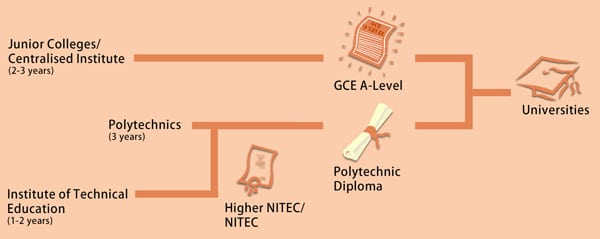Singapore solidifies its reputation as a regional education hub
The rise of the National University of Singapore (NUS) to the top of the QS University Rankings: Asia is the latest evidence of Singapore’s strengthened position as a regional education leader. Singapore’s Nanyang Technological University (NTU) also jumped in the rankings this year, from 9th position to 7th, cementing the reputation of Singapore’s top universities as among the region’s best. Korea Advanced Institute of Science and Technology (KAIST) followed NUS to secure second place. NUS supplanted The Hong Kong University of Science and Technology (HKUST) as the region’s top-ranked university. This is the first time since the QS Asia rankings began in 2009 that a university from Hong Kong has failed to secure the coveted top spot. In compiling the rankings, QS weighs factors such as academic and employer reputation, citations, numbers of international faculty and students, and inbound and outbound exchanges. In a recent University World News article, Ben Sowter, QS head of research, said the rankings confirm the emergence of Singapore and Korea as the region’s new major players in higher education, ending the dominance of Hong Kong and Japan. “Both NUS and KAIST have benefitted from major government investment in research; while operating in English has helped them attain new levels of global engagement,” he added. The rise of NUS and NTU in regional tables reflects the Singapore government’s commitment to funding a strategic, gradual expansion of its education system. As University World News notes, NUS and NTU are currently benefitting from a S$16.1 billion (US$12.9 billion) government programme to improve their performance in science, technology, and innovation.
Singapore’s universities rise at time of increased regional mobility
These regional shifts come at a time when the Association for Southeast Asian Nations (ASEAN) countries are ratcheting up ambitious goals for intra-regional student mobility. Plans for increased cooperation across the ASEAN states are anchored by four priority areas: student mobility, credit transfers, quality assurance, and the establishment of research clusters. Singapore is hoping that increased prestige of local institutions will also keep more of its own students closer to home. In support of that goal, in recent years it has launched an ambitious plan to expand higher education opportunities for Singaporean students. In response to these government priorities, many of Singapore’s universities have begun to grow student pathways from secondary to post-secondary institutions in order to support an increase in the number of domestic students studying in-country. Late last year, Channel NewsAsia highlighted how two Singaporean universities are increasing programme and pathway options for domestic students. The Singapore Institute of Management University (UniSIM), for example, is expanding offerings to include broad-based education in business and accounting, while the Singapore Institute of Technology (SIT) will offer highly specialised engineering programmes in rail and software. Both institutions were recently upgraded to university status by the Singapore government as part of far-reaching higher education reforms. In the article, Lim Biow Chuan, the chair of Singapore’s Government Parliamentary Committee for Education, said: “As we create more places for our local students, I suppose the hope is that more of our students will not think about going overseas unless they have no choice, but that they will enrol in the local universities.”
Increased pathway options part of slow, strategic expansion
Singapore hosts over 70,000 international students annually, although the government has begun to cap spaces for international students in order to expand space for domestic students in recent years. Nevertheless, Singapore remains an attractive destination as a safe, tolerant, multicultural, and technologically advanced country that also allows foreign students to work for up to 16 hours a week while enrolled in full-time studies.
A recent article in the Hong Kong Education Post highlights Singapore’s appeal to students from Hong Kong, in particular. According to the article, one of the key selling features for Hong Kong students is Singapore’s Tuition Grant Scheme (TGS), which helps offset the cost of tuition for international students. The Tuition Grant Scheme was introduced in 1980 and permits non-Singaporean students enrolled in full-time diploma or undergraduate courses in many institutions to apply for a tuition subsidy. Other attractive features for Hong Kong students include the use of English and Mandarin in the classroom and the geographical proximity of Singapore.

Cost challenges on the horizon
Even with these recent indications of Singapore’s continuing – even growing – strength as a regional hub, there are warning signs that growth in student numbers may become more difficult to achieve moving forward. Singapore’s economy remains strong – it managed growth of between 3.5 and 4% in 2013 – and unemployment and inflation are still relatively low. Rapid growth, however, has brought some challenges. According to East Asia Forum, one of the key hurdles facing the nation is how to maintain a strong quality of life for citizens. There are concerns in some quarters, for example, about increased poverty and the affordability of healthcare. For students (both domestic and international), one of the pressing concerns is the rising cost of living. A recent article in ChinaDaily Asia suggests that the very growth that drives Singapore’s robust economy has made it an increasingly expensive country in which to live and work. Indeed, the Economist Intelligence Unit (EIU) reports that Singapore has recently surpassed Tokyo as the world’s most expensive city. "Over the last decade, a 40% currency appreciation coupled with solid price inflation has consistently pushed Singapore up the ranking," said the EIU. The Strait Times adds, “There is little doubt that Singapore's high costs challenge the country's competitive edge.” The same article, however, also points out that the value Singapore adds as a business destination - strong global competitiveness and exceptional transportation links, among other factors - outweighs these rising costs. And fair to say that other cities in Asia are facing similar cost increases. In any case, concerns about cost have so far done little to challenge Singapore’s steady rise as a regional education power. With its leading universities now occupying two of the top spots in an important regional ranking, increasing attention will be paid to Singapore as both a destination for further study and as a leader in attracting impressive new talent to its shores.
















